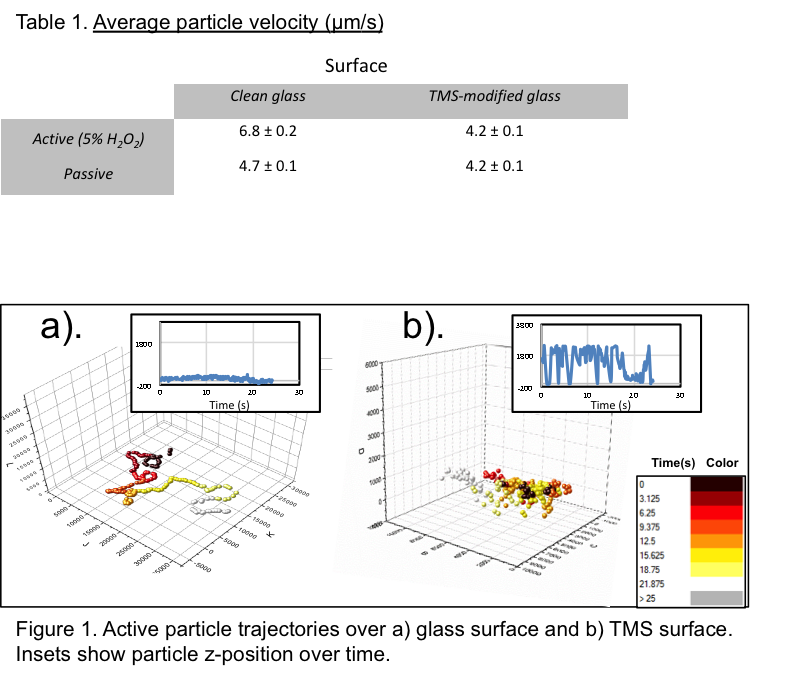2020 Virtual AIChE Annual Meeting
(43f) Influence of Surface Chemistry on Active Particle Dynamics Near the Solid-Liquid Interface
Authors
Non-equilibrium systems of active particles continue to attract intense interest in a variety of fields.1,2 Active particles that self-propel through asymmetric catalysis of H2O2 fuel have been reported to accumulate near surfaces and propel parallel to the solid-liquid interface.3 This affinity for the surface has been attributed to a complex interplay of coupled fluid dynamics and has been effectively leveraged to guide particles on physically patterned surfaces. Recent studies have investigated the role of substrate surface chemistry on the particle dynamics and the changing slip length on increasingly hydrophobic surfaces has been implicated in driving enhanced velocities of active particles4; however, in the current literature, a large distribution of velocities and surface affinities are reported. Moreover, conventional 2D tracking of particles near surfaces fails to fully capture fluctuations in the z-position, leading to uncertainty in the exact nature of any observed surface affinity. Here, we have addressed these questions through study of active particle dynamics over surfaces of different wettability using state-of-the-art 3D tracking. We have observed novel and substantial substrate-dependent differences in particle behavior (velocity, residence time, turning angle distribution) Further, we have developed parameter-driven models to more holistically understand these observations through simulation-based approaches.
Materials and Methods
Active fluorescent polystyrene particles with Janus Pt catalyst architecture were synthesized by dispersing a dilute suspension of fluorescent particles on a glass slide. A thin layer (10 nm) of Pt was then sputtered and the particles were liberated from the glass slide into clean water through brief sonication. Substrates with varying surface chemistries were prepared through vapor-phase silane modification of cleaned glass slides. Contact angle measures of all surfaces were obtained via static water contact angle observations. The particle dynamics were imaged using a Nikon N-Storm microscope equipped with a CMOS camera and three-dimensional localization of the particles was achieved through the use of a phase mask (Double Helix LLC). The particle trajectories were analyzed using DoubleHelix software as well as custom Matlab codes.
Results and Discussion
Significantly different active particle dynamics were observed over the different surfaces (clean glass, θ: ~0°, and TMS-modified glass, θ: ~90°). First, in contrast to recent reports, we observed the active particles near the clean glass surface exhibiting higher velocities than the active particles above the hydrophobic TMS surface (Table 1). When compared to the passive case (no H2O2 in solution), more interesting phenomena were observed: the active particles above the glass surface moved faster than the passive particles; however, over the TMS surface, the active particles moved at velocities comparable to the passive case.
Furthermore, while active particles accumulated near the solid-liquid interface over both surfaces, temporal analysis of the particle z-position (enabled by 3D tracking methods) revealed significant differences in particle dynamics over the two surfaces. Passive particles displayed standard Brownian-type motion over both surfaces with substantial fluctuations in the z position. Similarly, over the TMS surface, the active particles displayed âin and outâ dynamics with no strong affinity to propel near the surface. Only the active particles over the clean glass surface were observed to have strong surface affinity and extended surface trajectories were readily observed. Figure 1 shows two representative 3D trajectories of the observed behavior with inset highlighting the differing z-position behavior.
Further differences in particle dynamics were elucidated through analysis of the velocity autocorrelation function and turning angle of the particles (active and passive) over the different surfaces. Interestingly, the strong surface affinity of the active particles near the clean glass surface manifested in correlation in x and y velocity but strong anti-correlated motion in the z direction. In contrast, the active particles over the TMS surface as well as the passive particles above both surfaces displayed minimal correlation in any dimension, consistent with the observed lack of strong surface affinity of these particles. We sought to understand these dynamics through model development using empirical data to parameterize our model and simulations to help capture what real physical mechanisms describe this observed motion.
Significance
We have studied the behavior of active particles near the solid-liquid interface of both hydrophilic and hydrophobic substrates. Using 3D tracking, we have elucidated substantial surface chemistry-dependent differences in particle dynamics that manifest in the observed speed, VACF, turning angle, and surface residence time of the particles. We believe these results help provide a detailed view of interfacial active particle dynamics and contribute to the further development of precise strategies for fine control of active particle motion.
